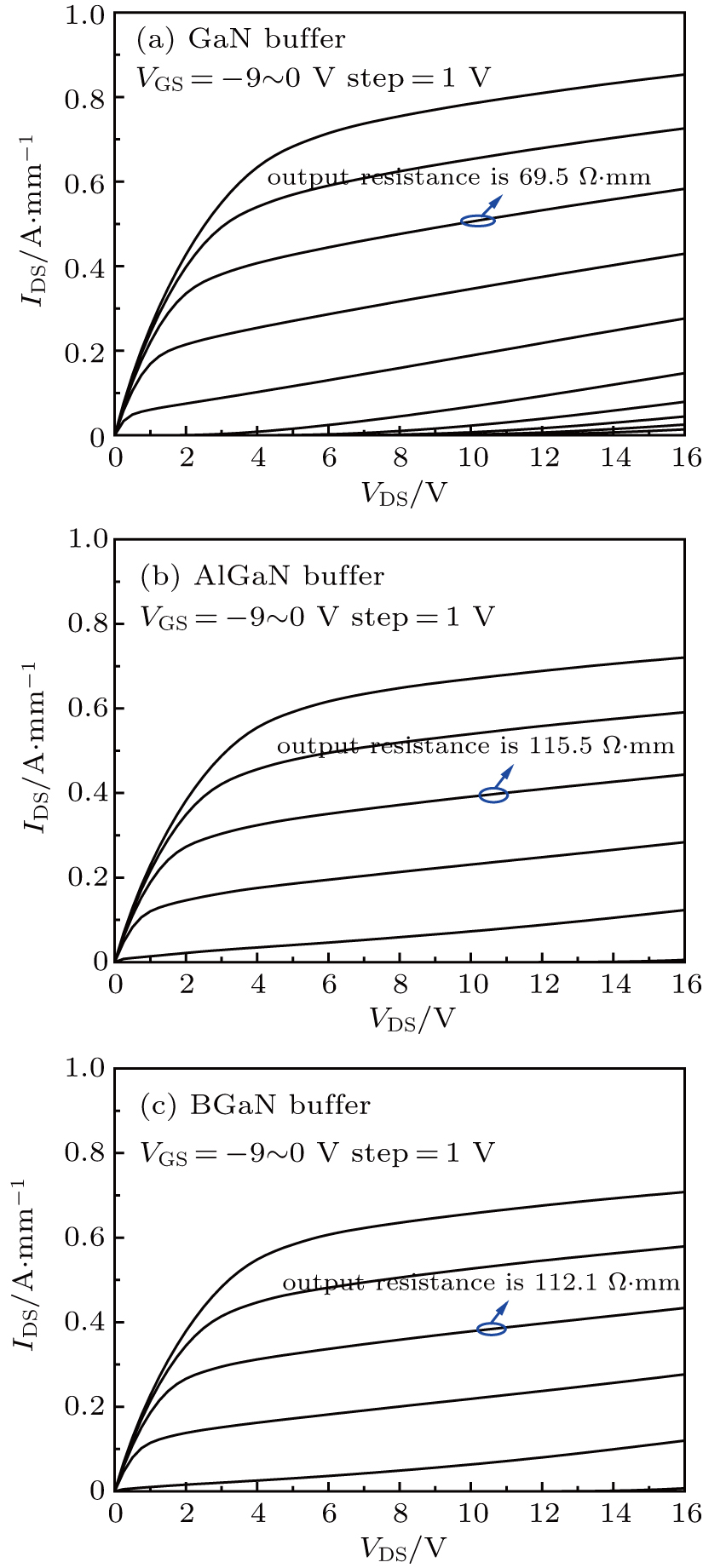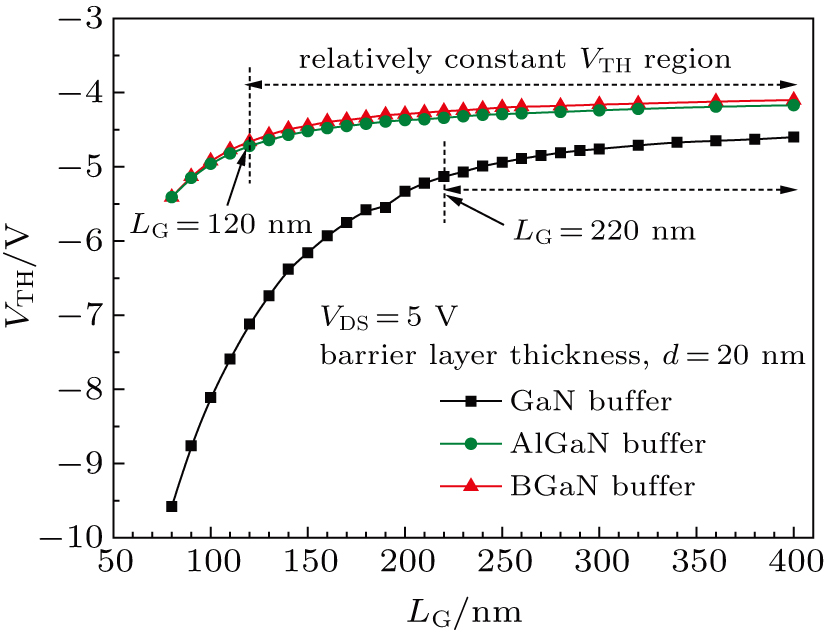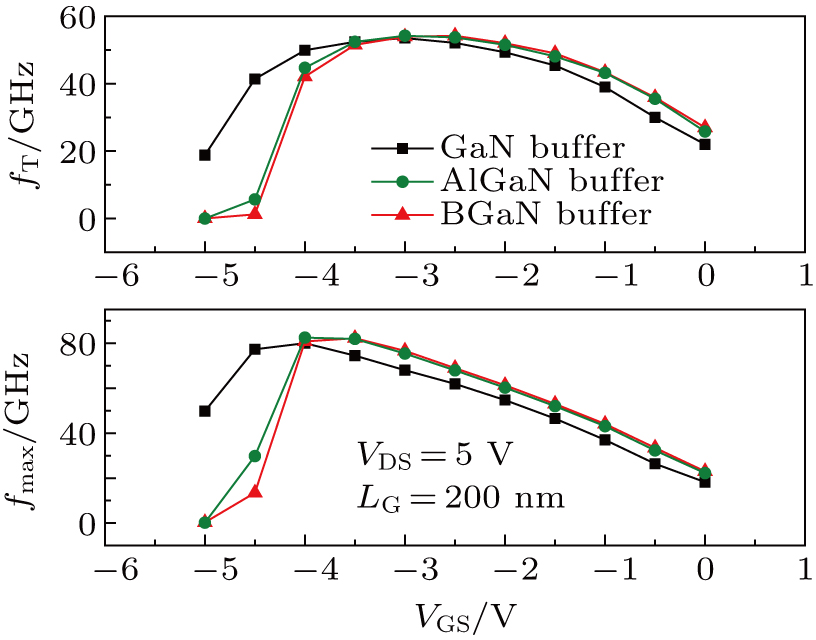† Corresponding author. E-mail:
Using the semi-insulating property and small lattice constant a of wurtzite BGaN alloy, we propose a BGaN buffer with a B-content of 1% to enhance two-dimensional electron gas (2DEG) confinement in a short-gate AlGaN/GaN high-electron mobility transistor (HEMT). Based on the two-dimensional TCAD simulation, the direct current (DC) and radio frequency (RF) characteristics of the AlGaN/GaN/B0.01Ga0.99N structure HEMTs are theoretically studied. Our results show that the BGaN buffer device achieves good pinch-off quality and improves RF performance compared with GaN buffer device. The BGaN buffer device can allow a good immunity to shift of threshold voltage for the aspect ratio (LG/d down to 6, which is much lower than that the GaN buffer device with LG/d=11 can reach. Furthermore, due to a similar manner of enhancing 2DEG confinement, the B0.01Ga0.99N buffer device has similar DC and RF characteristics to those the AlGaN buffer device possesses, and its ability to control short-channel effects (SCEs) is comparable to that of an Al0.03Ga0.97N buffer. Therefore, this BGaN buffer with very small B-content promises to be a new method to suppress SCEs in GaN HEMTs.
GaN high-electron-mobility transistors (HEMTs) are a promising candidate for high-frequency applications due to their excellent material properties.[1–3] To operate the device at a high frequency, the gate length (LG) needs to be shortened. However, when the aspect ratio (LG/d, where d is the gate-to-channel distance) downscales below 15,[4, 5] short-channel effects (SCEs), such as shift of threshold-voltage, high sub-threshold swings, and increased output conductance, will become evident, which limits further improvement in the device performance. Under a poor aspect ratio, the basic technical route to the suppressing of the SCEs is to improve the control of the gate-to-channel by enhancing two-dimensional electron gas (2DEG) confinement.[6–11]
Wurtzite (WZ) BGaN ternary alloys (hereafter BGaN), as an emerging member of the III-nitride family, have introduced many innovations in optical and electronic device applications.[12–14] It has been shown that the incorporation of a few percent of boron (0.3%–1.75%) into GaN to form BGaN can significantly reduce background n-type doping and increase the resistivity of the epitaxial layer.[12, 15, 16] Thus, the BGaN alloy can be an alternative solution for increasing the insulation of the GaN buffer by iron or carbon doping. Meanwhile, the lattice constant a of the BGaN material is smaller than that of GaN (0.3189 nm) due to the relatively small lattice constant a of WZ BN (0.253 nm).[17, 18] If thick BGaN is used as a buffer, the GaN channel grown on the completely lattice relaxed BGaN buffer will be under compressive strain, theoretically. The negative piezoelectric polarization charges can be generated at the GaN channel/BGaN buffer interface to enhance the 2DEG confinement. This manner to enhance 2DEG confinement is somewhat similar to the AlGaN buffer structure[11, 19–21] in which a sheet-like negative polarization charge is produced at the GaN channel/AlGaN buffer interface due to the spontaneous and piezoelectric polarization discontinuities. Using the semi-insulating property and small lattice constant a of BGaN alloy, the use of BGaN buffer promises to be a new method to suppress the SCEs. In addition, many studies on the growth of the BGaN on 6H–SiC and on GaN and AlN templates on sapphire are carried out by metalorganic chemical vapor deposition (MOCVD).[22–25] If only a very small B-content (1%) is incorporated into BGaN, then the growth conditions of BGaN and GaN are compatible.[22, 23]
In this paper, we propose a B0.01Ga0.99N buffer to enhance the 2DEG confinement in a short-gate AlGaN/GaN HEMT. To evaluate the ability of the BGaN buffer to control SCEs, the direct current (DC) and radio frequency (RF) characteristics of the BGaN buffer structure HEMTs are theoretically studied by the two-dimensional TCAD simulator (ATLAS). The HEMTs with a GaN buffer and an Al0.03Ga0.97N buffer are also simulated for comparison. The results show that the BGaN buffer HEMT has good pinch-off quality and improved RF performance compared with the GaN buffer HEMT. Due to a similar manner of enhancing 2DEG confinement, the B0.01Ga0.99N buffer device has similar DC and RF characteristics to those the AlGaN buffer device possesses, and its ability to control SCEs is comparable to that of Al0.03Ga0.97N buffer.
Figure 




 | Fig. 1. Cross-sectional schematics for (a) GaN buffer structure, (b) AlGaN buffer structure, and (c) BGaN buffer structure, respectively. |
The lattice constant a of BGaN and AlGaN are calculated by linear interpolation:
 |
 |
 |
 |
 |
 |
The lattice constants a and the energy-gaps of AlGaN and BGaN are calculated, as shown in Fig.
The spontaneous polarization (PSP) and the strain-induced piezoelectric polarization (PPE) are modeled as follows:[26]
 |
 |
 |
The sheet polarization charge density σ (C/m2) at top/bottom heterointerface is given by[27]
 |
Based on Eqs. (
The drift-diffusion transport model is used to simulate the electrical characteristics of the device, which can offer the fast convergence and relative acceptable accuracy. The physical model also includes Fermi–Dirac statistics, Shockley–Read–Hall, the low-field mobility, and the nitride specific field dependent mobility.
The low-field mobility is described by the Albrecht model as follows:[29]
 |
| Table 1.
Doping-dependent mobility parameters for electrons in simulations. . |
The nitride specific field-dependent mobility is modeled as follows:
 |
An Ni metal is assumed to form Schottky contact and the Schottky barrier height at the surface of the barrier layer (


At first, under zero applied voltage, the conduction-band profiles and electron distributions in the investigated structures are calculated by one-dimensional self-consistent simulation as shown in Fig.
Figure 



 | Fig. 4. Simulated I–V output characteristics for (a) GaN buffer HEMT, (b) Al0.03Ga0.97N buffer HEMT, and (c) B0.01Ga0.99N buffer HEMT. |
Figure
 | Fig. 5. (a) Gm–VGS and IDS–VGS transfer characteristics of devices at VDS = 5 V. (b) IDS–VGS transfer characteristics plotted by log-scale at VDS= 1 and 4 V for investigated devices, respectively. |
To further investigate the ability to control SCEs in the BGaN buffer HEMTs, the threshold voltage (VTH) is also simulated as a function of gate-length (LG) at VDS= 5 V as shown in Fig.
 | Fig. 6. Threshold voltage (VTH) as a function of gate length (LG) in investigated devices at VDS=5 V. |
The RF performance of the three devices is also calculated by small-signal AC simulation. Figure
To suppress SCEs, a B0.01Ga0.99N buffer is utilized to enhance 2DEG confinement in a short-gate AlGaN/GaN HEMT structure. Based on two-dimensional TCAD simulation, the DC and RF characteristics of the B0.01Ga0.99N buffer HEMT are theoretically studied. Comparing with the GaN buffer device, good pinched-off behavior and improved RF performance are obtained in the BGaN buffer device. As the gate length decreases, the BGaN buffer device with an LG/d of six has a good immunity to the shift of threshold voltage, which is much lower than that the GaN buffer device with LG/d = 11 possesses. Moreover, the B0.01Ga0.99N buffer device has similar dc and RF characteristics to those the AlGaN buffer device possesses, and its ability to control SCEs is comparable to that of Al0.03Ga0.97N buffer. Therefore, this BGaN buffer with very small B-content could be a new method to control SCEs. Therefore, this study provides a reference for the research of BGaN buffers.
| [1] | |
| [2] | |
| [3] | |
| [4] | |
| [5] | |
| [6] | |
| [7] | |
| [8] | |
| [9] | |
| [10] | |
| [11] | |
| [12] | |
| [13] | |
| [14] | |
| [15] | |
| [16] | |
| [17] | |
| [18] | |
| [19] | |
| [20] | |
| [21] | |
| [22] | |
| [23] | |
| [24] | |
| [25] | |
| [26] | |
| [27] | |
| [28] | |
| [29] | |
| [30] |







